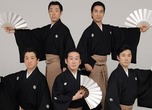
Posted: Mon Apr 26 2010
Tomitaro Zenchiku, kyogen performer
Are you taking your dog for a walk in the rain?
TZ: I’m on my way to the convenience store.
To buy some lunch?
TZ: I love the sekihan onigiri (rice ball with red azuki beans) from 7-Eleven; and I’ll probably pick up some ice cream as well.
Surely a guy like you needs more than a single onigiri? [Laughs]
TZ: [Laughs] I always get three.
What kind of work do you do for a living?
TZ: I perform kyogen. There are two main schools of kyogen: the Okura School and the Izumi School. I’m with the Okura School – however, in total, there’s only about 100 professional kyogen performers left in Japan.
This is the first time I’ve ever met someone who performs kyogen. I thought they always wore kimono. Isn’t there some sort of a dress code?
TZ: On stage I wear a crested hakama (a type of traditional dress). On the way to work I wear a suit, and when I dress casually I normally wear jeans or sportswear.
Is performing kyogen a family tradition?
TZ: Exactly. I started practicing at the age of three and gave my first performance at five – I played a baby monkey. If I had to play a monkey again now I’d be a gorilla, ha ha! It’s customary for kyogen performers to debut as the baby monkey in a musical performance of ‘Utsubozaru’ (‘The Monkey Skin Quiver’).
Have you ever thought to try something other than kyogen?
TZ: Of course! For example, when I was a child, I wanted to become a policeman; I even thought to join Ishihara Gundan [a loosely affiliated group of actors] at one point. Kyogen training in our family was tough, but I was also taught never to neglect my schoolwork. Every day, I’d go to school, practice kyogen, and after spending time playing baseball or something with friends I’d do my homework. However, during university I studied psychology – a subject that has absolutely nothing to do with kyogen. It wasn’t until then that I started to realize the importance of performing kyogen.
Can people who aren’t born into families with a tradition of kyogen become professional kyogen performers?
TZ: Absolutely. Some of the students at my studio don’t have any special heritage. There are also a lot of women who practice kyogen. They may not necessarily want to become professional performers, but with a little training, they can improve their posture and the way they speak. In kyogen you have to use a lot of facial muscles in order to project your voice, so the first step is to practice making various facial expressions. The various gestures in kyogen are very Japanese and very elegant.
Are there any particular types of etiquette involved in going to see kyogen?
TZ: Because it’s a form of comedy that dates back to the Muromachi period, many people have strange preconceptions regarding kyogen. For example, it’s often thought that to understand it you need to be interested in history and classical literature; however, in reality, you don’t have to have any special knowledge to laugh at the jokes and find the performances entertaining. A ‘Noh performance’ consists of both Noh and kyogen and, basically, you could look at Noh and kyogen as brothers. That being said, whereas Noh is often based around serious stories with plots involving subjects like death and the supernatural, many of the movements and expressions in kyogen are purposely performed to make the audience laugh – if you find something funny, feel free to laugh. I often perform in places such as the Noh Theatre in Shibuya’s Cerulean Tower and the National Noh Theatre – by all means, come and see me perform. In fact, my studio isn’t far from here, come and see for yourself if you like.
I’d love to!
TZ: Well then, please, walk this way. [Laughs]
More from Tomitaro:

‘Japan has myriads of gods and deities. The idea of suriashi, where people move by sliding their feet along the ground, came about from the feeling of not wanting to be separated from the gods in the floor.’
‘The language used in kyogen isn’t hard to follow when you pay attention to it. For example, kyogen often uses the expression “mazu, sorori sorori to mairou”, might seem a slightly odd at first. However, “sorori” basically means “without haste”, so the expression really just means “let us journey slowly and without haste”.’
‘In this neighbourhood, I’d recommend Borracho as a place to go for a proper meal, and Le Champ De Pierres as a place to go for something sweet.’
Tomitaro Zenchiku website: goodbamboo.net/
Tags:
Tweets
- About Us |
- Work for Time Out |
- Send us info |
- Advertising |
- Mobile edition |
- Terms & Conditions |
- Privacy policy |
- Contact Us
Copyright © 2014 Time Out Tokyo
















Add your comment